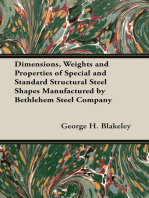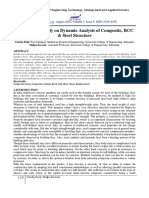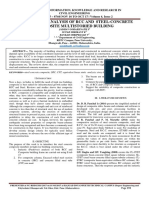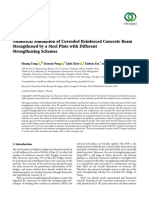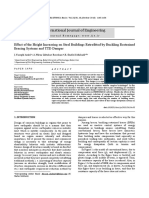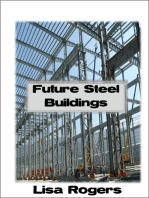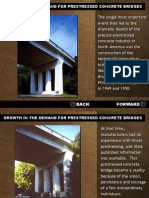Assignment. Engr Essay
Assignment. Engr Essay
Uploaded by
GopalDhakalCopyright:
Available Formats
Assignment. Engr Essay
Assignment. Engr Essay
Uploaded by
GopalDhakalOriginal Description:
Copyright
Available Formats
Share this document
Did you find this document useful?
Is this content inappropriate?
Copyright:
Available Formats
Assignment. Engr Essay
Assignment. Engr Essay
Uploaded by
GopalDhakalCopyright:
Available Formats
Comparative Study of R.C.
C and Steel Concrete Composite Structures
Mg.Gopal (VBEC-6) , Mg. Wai Yan Htun (VBEC-7)
ABSTRACT
Steel concrete composite construction has gained wide acceptance world wide as an alternative
to pure steel and pure concrete construction. The use of steel in construction industry is very low
in Myanmar compared to many developing countries. There is a great potential for increasing the
volume of steel in construction, especially in the current development needs and not using steel
as an alternative construction material and not using it where it is economical is a heavy loss for
the country. In this paper, some statistics from an engineering research article about the analysis
of four various multistoried commercial buildings, are brought.
Keywords- Composite beam, Composite column, Composite slab, R.C.C Structure.
1.INTRODUCTION
The word composite general in construction industry refers to steel-concrete composite
structure. The most important and most frequently encountered combination of construction
materials is that of steel and concrete, it has applications in multi-storey commercial buildings
and factories, as well as in bridges. These materials can be used in mixed structural systems, for
example concrete cores encircled by steel tubes, as well as in composite structures. Designing
composite systems of structural steel and reinforced concrete produces more efficient structures
when compared to designs using either material alone.
2. COMPOSITE MULTISTORIED BUILDINGS
2.1. COMPOSITE DECK SLAB
Composite floor system consists of steel beams, metal decking and concrete. They are
combined in a very efficient way so that the best properties of each material can be used to
optimize construction techniques. The most common arrangement found in composite floor
systems is a rolled or built-up steel beam connected to a formed steel deck and concrete slab.
2.2. COMPOSITE BEAM
In conventional composite construction, concrete slabs rest over steel beams and are
supported by them. Under load these two components act independently and a relative slip
occurs at the interface if there is no connection between them. With the help of a deliberate and
appropriate connection provided between them can be eliminated. In this case the steel beam and
the slab act as a “composite beam” and their action is similar to that of a monolithic Tee beam.
Shweta A. Wagh et al Int. Journal of Engineering Research and Applications
ISSN: 2248-9622, Vol.4, Issue 4(Version1), April 2014, pp.369-376
2.3. COMPOSITE COLUMN
A steel concrete composite column is a compression member, comprising either of a
concrete encased hot rolled steel section or a concrete filled hollow section of hot rolled steel. It
is generally used as a load bearing member in a composite framed structure. Composite members
are mainly subjected to compression and bending.
3. BOND OR ANCHORAGE TYPE
It is used to resist horizontal shear and to prevent separation of girder from the concrete
slab at the interface through bond. These connectors derived from the resistance through bond
and anchorage action.
4. COMPARATIVE ANALYSIS
This comparative study was done by Shweta A. Wagh and Dr. U.P. Waghe. They have
considered a commercial building. The plan dimension was 63.2mx29.5m. The study was carried
out on the same building plan for both R.C.C and Composite construction using STAAD.Pro.
The basic loading on both types of structures were kept same. The study had provided the
following comparison bar charts.
Fig.1: Comparison of deflection of a particular column
Fig.2: Comparison of SF of a particular column in X-direction
Fig.3: Comparison of BM of a particular column in Z-direction
Fig.4: Cost Comparison Bar Chart
4.Disccussion
From the analysis and comparison between the two structure types, the following conclusion can
be drawn out-
1. In case of a composite structural system because of the lesser magnitude of the beam end
forces and moments compared to an R.C.C system, one can use lighter section in a
composite structure.
2. Because of the lesser downward reaction in composite structure, one can use smaller size
of foundation.
3. Under earthquake consideration because of inherent ductility characteristics, steel-
concrete composite structure perform better than a R.C.C structure.
4. The cost comparison reveals that steel-concrete composite design structure is more
economical in case of high rise buildings and construction is speedy.
REFERENCES
1. Johnson R. P., Composite Structures of Steel and Concrete, Volume 1, Blackwell
Scientific Publications, UK, 2004.
2. Fisher J. w. Design of composite beams with formed metal deck. Eng. J,, amer, lnst ,Steel
Constr,7.88-96,July 1970.
3. Euro code 4, ―Design of composite steel and concrete structure, European committee
for standardization committee European de normalization europaisches committee fur
normung.
4. IS: 456(2000), ― Indian Standard Code of Practice for Plan and Reinforcement
You might also like
- SBC Code 303Document97 pagesSBC Code 303dyx90% (10)
- Reinforced Concrete Buildings: Behavior and DesignFrom EverandReinforced Concrete Buildings: Behavior and DesignRating: 5 out of 5 stars5/5 (1)
- Dimensions, Weights and Properties of Special and Standard Structural Steel Shapes Manufactured by Bethlehem Steel CompanyFrom EverandDimensions, Weights and Properties of Special and Standard Structural Steel Shapes Manufactured by Bethlehem Steel CompanyNo ratings yet
- Clean Room SpecificationsDocument5 pagesClean Room Specificationsvalentinlupascu33100% (1)
- New HummerDocument49 pagesNew HummerFerenc Schmidt100% (1)
- Azenkot A. Irrigation DesignDocument86 pagesAzenkot A. Irrigation DesignJay MartinNo ratings yet
- RCC 1 PDFDocument8 pagesRCC 1 PDFNgọc TuyênNo ratings yet
- An Analytical and Comparitive Study of Composite and RCC Multi Storey BuildingsDocument15 pagesAn Analytical and Comparitive Study of Composite and RCC Multi Storey BuildingsRakkeshKudullaNo ratings yet
- IRJET-V10I933 (1) (1)Document8 pagesIRJET-V10I933 (1) (1)ARUN KUMAR YADAVNo ratings yet
- Study of Seismic and Wind Effect On Multi Storey R.C.C. Steel and Composite BuildingDocument6 pagesStudy of Seismic and Wind Effect On Multi Storey R.C.C. Steel and Composite BuildingAkshay DobleNo ratings yet
- Seismic Analysis of RCC and Composite StructuresDocument9 pagesSeismic Analysis of RCC and Composite Structuresvishnumani3011No ratings yet
- Compare Studu PDFDocument5 pagesCompare Studu PDFdarsu NaikNo ratings yet
- Jounal Composite 4Document11 pagesJounal Composite 4barath kumarNo ratings yet
- Steel ConDocument22 pagesSteel Consantosh bharathyNo ratings yet
- IJRPR16287Document6 pagesIJRPR16287B45Raj Kumar ThakurNo ratings yet
- Analysis and Design of Multi-Storeyed Building by Steel Concrete Composite StructureDocument9 pagesAnalysis and Design of Multi-Storeyed Building by Steel Concrete Composite StructureUsha EngineeringNo ratings yet
- COMPARATIVE STUDY OF RCC STEEL AND COMPOSITE STRUCTURES FOR INDUSTRIAL BUILDING Ijariie10646Document11 pagesCOMPARATIVE STUDY OF RCC STEEL AND COMPOSITE STRUCTURES FOR INDUSTRIAL BUILDING Ijariie10646NikhilARNo ratings yet
- Comparative Study On Multi-Storey Structure of R.C.C and Composite MaterialDocument5 pagesComparative Study On Multi-Storey Structure of R.C.C and Composite MaterialBasavarajBachihalNo ratings yet
- Kamal - 2015 - Encased Beam With Variable Upper SteelDocument8 pagesKamal - 2015 - Encased Beam With Variable Upper SteelRene Rodrigues O. SilvaNo ratings yet
- Composite Cold-Formed Steel-Concrete Structural System Composite Cold-Formed Steel-Concrete Structural SystemDocument27 pagesComposite Cold-Formed Steel-Concrete Structural System Composite Cold-Formed Steel-Concrete Structural SystemVladimirNo ratings yet
- Comparative Study On Dynamic Analysis of Composite, RCC & Steel StructureDocument8 pagesComparative Study On Dynamic Analysis of Composite, RCC & Steel StructureRajalakshmi JothivelNo ratings yet
- Comparative Analysis of RCC and Steel-Concrete Composite Multistoried BuildingDocument7 pagesComparative Analysis of RCC and Steel-Concrete Composite Multistoried BuildingAbhishek GuptaNo ratings yet
- Panchal (Nirma University) - Comparative Study of RCC-Steel-Composite High Rise BuildingDocument6 pagesPanchal (Nirma University) - Comparative Study of RCC-Steel-Composite High Rise Buildingnvc_vishwanathanNo ratings yet
- Analysis and Design of Multi-Storeyed Bu PDFDocument8 pagesAnalysis and Design of Multi-Storeyed Bu PDFengyana engyyyNo ratings yet
- Innovation in Composite ConstructionDocument6 pagesInnovation in Composite ConstructionnicholasNo ratings yet
- Paper 2Document7 pagesPaper 2Josue OrtizNo ratings yet
- Objective/Scope: Arranged by Erkan SAMHÂL From SSEDTA (European Steel Computer Aided Learning), April 2005Document12 pagesObjective/Scope: Arranged by Erkan SAMHÂL From SSEDTA (European Steel Computer Aided Learning), April 2005CIVIL ENGG. SVESNo ratings yet
- Chapter Five Composite Structures (Concrete and Steel)Document15 pagesChapter Five Composite Structures (Concrete and Steel)Assefa Nigussie100% (1)
- 7 El-Ghazouli, DowlingDocument23 pages7 El-Ghazouli, DowlingYap Wen KhongNo ratings yet
- Bridge Engineering: Prof. Nirjhar DhangDocument24 pagesBridge Engineering: Prof. Nirjhar DhangSulabh BiswasNo ratings yet
- Research On RC/SRC Column Systems: Gregory G Deierlein and Hiroshi NOGUCHIDocument7 pagesResearch On RC/SRC Column Systems: Gregory G Deierlein and Hiroshi NOGUCHIKrishna MurariNo ratings yet
- Composite Construction and Cable Tensile StructureDocument86 pagesComposite Construction and Cable Tensile StructureBill Ely BalagotNo ratings yet
- Comparison of Aisc 360 - 16 and Ec4 For The Prediction of Composite Column Capacity (#612280) - 795121Document20 pagesComparison of Aisc 360 - 16 and Ec4 For The Prediction of Composite Column Capacity (#612280) - 795121mohamed alyozbakiNo ratings yet
- Research PaperDocument8 pagesResearch Papersameerbasra93No ratings yet
- Research PaperDocument9 pagesResearch Papersameerbasra93No ratings yet
- 2.4 Related LiteratureDocument2 pages2.4 Related LiteratureqdalquiambaoNo ratings yet
- Research On Application of Steel and Concrete Mixed Structure in High-Rise BuildingsDocument7 pagesResearch On Application of Steel and Concrete Mixed Structure in High-Rise Buildingsrui yangruixiNo ratings yet
- Bt5-Research-Work (Group 5)Document11 pagesBt5-Research-Work (Group 5)alyssamandap01No ratings yet
- 1-s2.0-S2214509516300444-mainDocument15 pages1-s2.0-S2214509516300444-mainManavia Alexandra AmoryNo ratings yet
- A Review On Concrete Filled Steel Tubes Column: December 2015Document7 pagesA Review On Concrete Filled Steel Tubes Column: December 2015Dony DoanxNo ratings yet
- Research ArticleDocument19 pagesResearch ArticleRomanbabu OinamNo ratings yet
- Researchpaper Design Model of Built Up Stiffened Column Base Under Large Eccentric LoadDocument10 pagesResearchpaper Design Model of Built Up Stiffened Column Base Under Large Eccentric LoadNishant GaurNo ratings yet
- Hou 2016Document12 pagesHou 2016Evonne LeeNo ratings yet
- SCS Protective StructureDocument18 pagesSCS Protective Structure안진호 / 학생 / 건설환경공학부No ratings yet
- 1 s2.0 S111001681730128X MainDocument20 pages1 s2.0 S111001681730128X MainDima OvsiiNo ratings yet
- Experimental and Analytical Study On Fatigue Behavior of Composite Truss JointsDocument17 pagesExperimental and Analytical Study On Fatigue Behavior of Composite Truss JointsOanh PhanNo ratings yet
- Introduction To Composite ConstructionDocument40 pagesIntroduction To Composite Constructionrameshbabu_1979100% (1)
- Research PaperDocument9 pagesResearch Papersameerbasra93No ratings yet
- International Journal of EngineeringDocument10 pagesInternational Journal of Engineeringparth daxiniNo ratings yet
- Composite Steel-Concrete Construction For New Zealand: P. Chunhaviriyakul, G.A. MacraeDocument30 pagesComposite Steel-Concrete Construction For New Zealand: P. Chunhaviriyakul, G.A. MacraeCIVIL ENGG. SVESNo ratings yet
- Review On Performance Analysis of Steel Concrete Composite SectionDocument3 pagesReview On Performance Analysis of Steel Concrete Composite SectionKaran SadhwaniNo ratings yet
- A Review On Concrete Filled Steel Tubes Column: December 2015Document7 pagesA Review On Concrete Filled Steel Tubes Column: December 2015Sushant WaghmareNo ratings yet
- Steel Conc. Comp. ContDocument35 pagesSteel Conc. Comp. ContDeepak SinghNo ratings yet
- Composite Construction MethoddDocument13 pagesComposite Construction MethoddEditha BaniquedNo ratings yet
- Experimental and Numerical Investigation On Full-Scale Tension-Only CBF Steel Beam Through FramesDocument18 pagesExperimental and Numerical Investigation On Full-Scale Tension-Only CBF Steel Beam Through FramesponjoveNo ratings yet
- Journal Article - Comparison RCC - CompositeDocument6 pagesJournal Article - Comparison RCC - CompositeSri KayNo ratings yet
- Numerical Analysis of Composite Steel Concrete Structural Shear Walls With Steel Encased ProfilesDocument12 pagesNumerical Analysis of Composite Steel Concrete Structural Shear Walls With Steel Encased ProfilesAnonymous mcHqIfbnV1No ratings yet
- Vayas2018 PDFDocument42 pagesVayas2018 PDFDaniel JaraNo ratings yet
- Concrete Filled Steel Tubular (CFST) Columns in Composite StructuresDocument8 pagesConcrete Filled Steel Tubular (CFST) Columns in Composite Structuresashish SindhuNo ratings yet
- Seismic Behavior of Steel-Concrete Composite Structures: December 2019Document7 pagesSeismic Behavior of Steel-Concrete Composite Structures: December 2019Usha EngineeringNo ratings yet
- Numerical Study of R.C. Beams Strengthening by External Steel PlateDocument9 pagesNumerical Study of R.C. Beams Strengthening by External Steel PlateAJER JOURNALNo ratings yet
- Experimental Study On Behaviour of Composite Column CFTDocument7 pagesExperimental Study On Behaviour of Composite Column CFTnilkanthNo ratings yet
- Journal of The South African Institution of Civil EngineeringDocument15 pagesJournal of The South African Institution of Civil Engineeringkranthi142434No ratings yet
- Rigle de CuplareDocument12 pagesRigle de CuplareMarius DanNo ratings yet
- Introduction and Properties of Pure SubstancesDocument63 pagesIntroduction and Properties of Pure SubstancesTushyNo ratings yet
- Appendices Meeting 11 Sept 2019Document176 pagesAppendices Meeting 11 Sept 2019aseNo ratings yet
- Las 9Document14 pagesLas 9HisokaNo ratings yet
- PerpanDocument7 pagesPerpanT Bagus Tri LusmonoNo ratings yet
- PSP LabDocument5 pagesPSP LabShaban SattiNo ratings yet
- Boiler Information - TDLRDocument5 pagesBoiler Information - TDLRCarl CrowNo ratings yet
- Final Presentation Electricity, HVAC, Vertical TransportationDocument76 pagesFinal Presentation Electricity, HVAC, Vertical TransportationsmarunNo ratings yet
- Armox BendingDocument58 pagesArmox BendingMOHAC KILICASLANNo ratings yet
- Flexpave NewFlexib 01 PDFDocument4 pagesFlexpave NewFlexib 01 PDFRahul RanaNo ratings yet
- Flanges, Gaskets, FastnersDocument48 pagesFlanges, Gaskets, Fastnersanand bandekarNo ratings yet
- Result ID 2270 SomDocument23 pagesResult ID 2270 Somsgumble3007No ratings yet
- Natural Ventilation Engineering GuideDocument40 pagesNatural Ventilation Engineering GuidePrestoneK100% (2)
- LS-32001-BCR Benchtop Reactor Teaching Unit Process Flow Dia PDFDocument1 pageLS-32001-BCR Benchtop Reactor Teaching Unit Process Flow Dia PDFMohammad Amir AliNo ratings yet
- Structural Steel - S235, S275, S355 Chemical Composition, Mechanical Properties and Common ApplicationsDocument14 pagesStructural Steel - S235, S275, S355 Chemical Composition, Mechanical Properties and Common Applicationsnaveenbaskaran1989No ratings yet
- Bawal First Floor Plan NewDocument1 pageBawal First Floor Plan NewNikki ChauhanNo ratings yet
- Lecture 1 Solid MechanicsDocument32 pagesLecture 1 Solid MechanicsVijayaraghavan G100% (1)
- Types of Crack in WeldingDocument8 pagesTypes of Crack in WeldingRAVI KATHIRAVANNo ratings yet
- Mechanics of Composite Materials, Second Edition: Autar K KawDocument7 pagesMechanics of Composite Materials, Second Edition: Autar K KawAnonymous QlJjisdlLINo ratings yet
- Saiver Fan CoilDocument1 pageSaiver Fan Coildarwish1982No ratings yet
- IMT G5 Suspended Plate MagnetsDocument2 pagesIMT G5 Suspended Plate Magnetssusmita.sivasankaranNo ratings yet
- Legris Installation of FittingsDocument30 pagesLegris Installation of Fittingsritesh_4luv7679No ratings yet
- BridgeDocument12 pagesBridgesoumyakuriakoseNo ratings yet
- new-construction-home-inspection-checklistDocument1 pagenew-construction-home-inspection-checklistAndreia TiburcioNo ratings yet
- Circular Water Tank (Flexible Joint)Document7 pagesCircular Water Tank (Flexible Joint)PUNARVI INFRASTRUCTURENo ratings yet
- Sling-Choker Manufacturing Lifting ProduDocument56 pagesSling-Choker Manufacturing Lifting ProduMiguel CarrizoNo ratings yet


